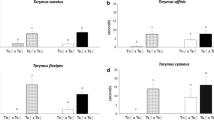Abstract
Four years after the release of two exotic parasitoids, Amitus hesperidum Silvestri (Hymenoptera: Platygasteridae) and Encarsia perplexa Huang and Polaszek (Hymenoptera: Aphelinidae) for the classical biological control of the citrus blackfly (CBF), Aleurocanthus woglumi Ashby (Hemiptera: Aleyrodidae) in Dominica, a survey was conducted to assess establishment as well as potential nontarget effects especially on Aleyrodidae and other related taxa. CBF populations were low to non-existent in 50 of 51 field sites examined. At the site where CBF was encountered, both E. perplexa and A. hesperidum were present and CBF populations were declining. The two parasitoids were not among the several species collected on nontarget Aleryodidae and Hemiptera. It is concluded that E. perplexa and A. hesperidum have kept CBF populations under effective biological control in Dominica and there is no evidence of any nontarget effects on other Aleyrodidae or their natural enemies.
Similar content being viewed by others
References
Anonymous (1974a) New United States record—orange spiny whitefly (Aleurocanthus spiniferus Quaintance). Hawaii Coop Econ Insect Rep 24:585
Anonymous (1974b) The citrus blackfly problem. Noticias Agricolas 7:27–28
Babendreier D, Kuske S, Bigler F (2003) Non-target host acceptance and parasitism by Trichogramma brassicae Bezdenko (Hymenoptera: Trichogrammatidae) in the laboratory. Biol Control 26:128–138
Barratt BIP, Blossey B, Hokkanen HMT (2006) Post-release evaluation of non-target effects of biological control agents. In: Bigler F, Babendreier D, Kuhlmann U (eds) Environmental impact of invertebrates for biological control of arthropods. CABI Publishing, Wallingford, pp 166–186
Boettner GH, Elkinton JS, Boettner CJ (2000) Effects of a biological control introduction on three nontarget native species of saturniid moths. Conserv Biol 14:1798–1806
Cherry R, Pastor S Jr (1980) Variations in population levels of citrus blackfly, Aleurocanthus woglumi (Hom.: Aleyrodidae) and parasites during an eradication program in Florida. Entomophaga 25:365–368
Cock MJW (2003) Risks of non-target impact versus stakeholder benefits in classical biological control of arthropods: selected case studies from developing countries. In: First International Symposium on biological control of arthropods, vol 1. Honolulu, Hawaii, 14–18 January 2002, USDA-Forest Service FHTET-03-05
Flanders SE (1969) Herbert Smith’s observations on citrus blackfly parasites in India and Mexico and the correlated circumstances. Can Entomol 101:467–480
Hawkins BA, Marino PC (1997) The colonization of native phytophagous insects in North America by exotic parasitoids. Oecologia 112:566–571
Hoy M (2005) Classical biological control of citrus pests in Florida and the Caribbean: interconnections and sustainability. In: Second international symposium on biological control of arthropods, vol 1. Davos, Switzerland. 12–16 September 2005. USDA Forest Service Publication FHTET-2005–2008. pp 237–253
International Institute of Entomology (1995) Distribution maps of pests. Series A. No. 91 (3rd revision). CAB International, Wallingford, UK
Johnson MT, Follett PA, Taylor AD, Jones VP (2005) Impacts of biological control and invasive species on a non-target native Hawaiian insect. Oecologia 142:529–540
Kairo MTK, Lopez VF, Pollard GV, Hector R (2001) Biological control of Aleurodicus pulvinatus (Homoptera: Aleyrodidae) in Nevis. Biocontrol News Inf 22:45–51
Lopez VF, Kairo MTK (2003) Prey range of Nephaspis bicolor Gordon (Coleoptera: Coccinellidae), a potential biological control agent of Aleurodicus dispersus and other Aleurodicus spp. (Homoptera: Aleyrodidae). Int J Pest Manage 49:75–88
Lopez VF, Kairo MTK, Bacon P, Khan A (2005) Bioecology of whiteflies (Aleyrodidae) in Trinidad & Tobago. Living World, J Trinidad & Tobago Field Nat Club 2005:15–22
Louda SM, Pemberton RW, Johnson MT, Follett PA (2003) Nontarget effects–the Achilles’ heel of biological control? Retrospective analyses to reduce risk associated with biocontrol introductions. Annu Rev Entomol 48:365–396
Lynch LD, Hokkanen HMT, Babendreier D, Bigler F, Burgio G, Gao Z-H, Kuske S, Loomans A, Menzler-Hokkanen I, Thomas MB, Tommasini G, Waage JK, van Lenteren JC, Zeng Q-Q (2001) Insect biological control and non-target effects: a European perspective. In: Wajnberg E, Scott JK, Quimby PC (eds) Evaluating indirect ecological effects of biological control. CABI, Wallingford, pp 99–125
Martin U (1999) Citrus blackfly in Dominica. Trop Fruits Newsl 32:3–6
Martin JH, Watson GW (1998) Aleurodicus pulvinatus Maskell (Homoptera: Aleyrodidae), and its emergence as a pest of coconut in the Caribbean. J Nat Hist 32:85–98
Smith HD, Maltby HL, Jimenez EJ (1964) Biological control of the citrus blackfly in Mexico. United States Department of Agriculture Technical Bulletin 1311. 30 pp
Stiling P (2004) Biological control not on target. Biol Invasions 6:151–159
Sullivan DJ, Völkl W (1999) Hyperparasitism: Multitrophic ecology and behaviour. Annu Rev Entomol 44:291–315
Summy KR, Gilstrap FE, Hart WG, Caballero JM, Saenz I (1983) Biological control of citrus blackfly (Homoptera: Aleyrodidae) in Texas. Environ Entomol 12:783–786
Summy KR, Gilstrap FE, Hart WG (1986) Correlation between flight trap response and foliar densities of citrus blackfly, Aleurocanthus woglumi (Homoptera: Aleyrodidae). Can Entomol 118:81–83
Watts WS, Alam M (1973) Spray trials against the citrus blackfly (Homoptera: Aleyrodidae) on limes in the Oman. Miscellaneous Report, Overseas Development Administration, Foreign and Commonwealth Office No. 8, 7 pp
White G, Kairo MTK, Lopez V (2005) Classical biological control of the citrus blackfly Aleurocanthus woglumi by Amitus hesperidum in Trinidad. BioControl 50:751–759
Acknowledgments
We are grateful to Drs. J. Martin/G.W. Watson and A. Polaszek of NHM, London for the identification of the Hemiptera and Hymenoptera, respectively. The study was a part of the activities funded by the Food and Agriculture Organization (FAO) Technical Cooperation Project—TCP/DMI/8922—Management of Citrus Blackfly in Dominica.
Author information
Authors and Affiliations
Corresponding author
Additional information
Handling Editor: Dirk Babendreier.
Rights and permissions
About this article
Cite this article
Lopez, V.F., Kairo, M.T.K., Pollard, G.V. et al. Post-release survey to assess impact and potential host range expansion by Amitus hesperidum and Encarsia perplexa, two parasitoids introduced for the biological control of the citrus blackfly, Aleurocanthus woglumi in Dominica. BioControl 54, 497–503 (2009). https://doi.org/10.1007/s10526-008-9207-4
Received:
Accepted:
Published:
Issue Date:
DOI: https://doi.org/10.1007/s10526-008-9207-4




